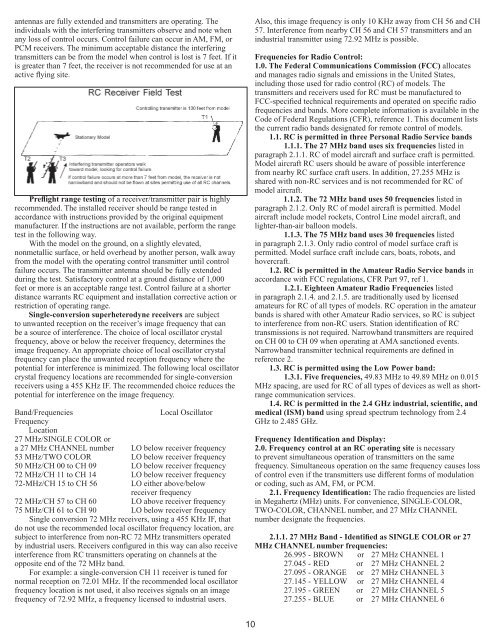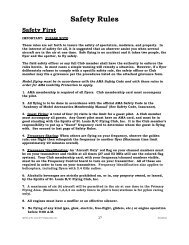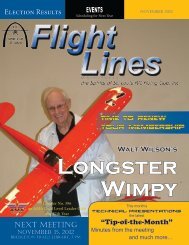Membership Manual - Spirits of St. Louis R/C Flying Club
Membership Manual - Spirits of St. Louis R/C Flying Club
Membership Manual - Spirits of St. Louis R/C Flying Club
You also want an ePaper? Increase the reach of your titles
YUMPU automatically turns print PDFs into web optimized ePapers that Google loves.
antennas are fully extended and transmitters are operating. The<br />
individuals with the interfering transmitters observe and note when<br />
any loss <strong>of</strong> control occurs. Control failure can occur in AM, FM, or<br />
PCM receivers. The minimum acceptable distance the interfering<br />
transmitters can be from the model when control is lost is 7 feet. If it<br />
is greater than 7 feet, the receiver is not recommended for use at an<br />
active flying site.<br />
Preflight range testing <strong>of</strong> a receiver/transmitter pair is highly<br />
recommended. The installed receiver should be range tested in<br />
accordance with instructions provided by the original equipment<br />
manufacturer. If the instructions are not available, perform the range<br />
test in the following way.<br />
With the model on the ground, on a slightly elevated,<br />
nonmetallic surface, or held overhead by another person, walk away<br />
from the model with the operating control transmitter until control<br />
failure occurs. The transmitter antenna should be fully extended<br />
during the test. Satisfactory control at a ground distance <strong>of</strong> 1,000<br />
feet or more is an acceptable range test. Control failure at a shorter<br />
distance warrants RC equipment and installation corrective action or<br />
restriction <strong>of</strong> operating range.<br />
Single-conversion superheterodyne receivers are subject<br />
to unwanted reception on the receiver’s image frequency that can<br />
be a source <strong>of</strong> interference. The choice <strong>of</strong> local oscillator crystal<br />
frequency, above or below the receiver frequency, determines the<br />
image frequency. An appropriate choice <strong>of</strong> local oscillator crystal<br />
frequency can place the unwanted reception frequency where the<br />
potential for interference is minimized. The following local oscillator<br />
crystal frequency locations are recommended for single-conversion<br />
receivers using a 455 KHz IF. The recommended choice reduces the<br />
potential for interference on the image frequency.<br />
Band/Frequencies<br />
Local Oscillator<br />
Frequency<br />
Location<br />
27 MHz/SINGLE COLOR or<br />
a 27 MHz CHANNEL number LO below receiver frequency<br />
53 MHz/TWO COLOR LO below receiver frequency<br />
50 MHz/CH 00 to CH 09 LO below receiver frequency<br />
72 MHz/CH 11 to CH 14 LO below receiver frequency<br />
72-MHz/CH 15 to CH 56 LO either above/below<br />
receiver frequency<br />
72 MHz/CH 57 to CH 60 LO above receiver frequency<br />
75 MHz/CH 61 to CH 90 LO below receiver frequency<br />
Single conversion 72 MHz receivers, using a 455 KHz IF, that<br />
do not use the recommended local oscillator frequency location, are<br />
subject to interference from non-RC 72 MHz transmitters operated<br />
by industrial users. Receivers configured in this way can also receive<br />
interference from RC transmitters operating on channels at the<br />
opposite end <strong>of</strong> the 72 MHz band.<br />
For example: a single-conversion CH 11 receiver is tuned for<br />
normal reception on 72.01 MHz. If the recommended local oscillator<br />
frequency location is not used, it also receives signals on an image<br />
frequency <strong>of</strong> 72.92 MHz, a frequency licensed to industrial users.<br />
Also, this image frequency is only 10 KHz away from CH 56 and CH<br />
57. Interference from nearby CH 56 and CH 57 transmitters and an<br />
industrial transmitter using 72.92 MHz is possible.<br />
Frequencies for Radio Control:<br />
1.0. The Federal Communications Commission (FCC) allocates<br />
and manages radio signals and emissions in the United <strong>St</strong>ates,<br />
including those used for radio control (RC) <strong>of</strong> models. The<br />
transmitters and receivers used for RC must be manufactured to<br />
FCC-specified technical requirements and operated on specific radio<br />
frequencies and bands. More complete information is available in the<br />
Code <strong>of</strong> Federal Regulations (CFR), reference 1. This document lists<br />
the current radio bands designated for remote control <strong>of</strong> models.<br />
1.1. RC is permitted in three Personal Radio Service bands<br />
1.1.1. The 27 MHz band uses six frequencies listed in<br />
paragraph 2.1.1. RC <strong>of</strong> model aircraft and surface craft is permitted.<br />
Model aircraft RC users should be aware <strong>of</strong> possible interference<br />
from nearby RC surface craft users. In addition, 27.255 MHz is<br />
shared with non-RC services and is not recommended for RC <strong>of</strong><br />
model aircraft.<br />
1.1.2. The 72 MHz band uses 50 frequencies listed in<br />
paragraph 2.1.2. Only RC <strong>of</strong> model aircraft is permitted. Model<br />
aircraft include model rockets, Control Line model aircraft, and<br />
lighter-than-air balloon models.<br />
1.1.3. The 75 MHz band uses 30 frequencies listed<br />
in paragraph 2.1.3. Only radio control <strong>of</strong> model surface craft is<br />
permitted. Model surface craft include cars, boats, robots, and<br />
hovercraft.<br />
1.2. RC is permitted in the Amateur Radio Service bands in<br />
accordance with FCC regulations, CFR Part 97, ref 1.<br />
1.2.1. Eighteen Amateur Radio Frequencies listed<br />
in paragraph 2.1.4. and 2.1.5. are traditionally used by licensed<br />
amateurs for RC <strong>of</strong> all types <strong>of</strong> models. RC operation in the amateur<br />
bands is shared with other Amateur Radio services, so RC is subject<br />
to interference from non-RC users. <strong>St</strong>ation identification <strong>of</strong> RC<br />
transmissions is not required. Narrowband transmitters are required<br />
on CH 00 to CH 09 when operating at AMA sanctioned events.<br />
Narrowband transmitter technical requirements are defined in<br />
reference 2.<br />
1.3. RC is permitted using the Low Power band:<br />
1.3.1. Five frequencies, 49.83 MHz to 49.89 MHz on 0.015<br />
MHz spacing, are used for RC <strong>of</strong> all types <strong>of</strong> devices as well as shortrange<br />
communication services.<br />
1.4. RC is permitted in the 2.4 GHz industrial, scientific, and<br />
medical (ISM) band using spread spectrum technology from 2.4<br />
GHz to 2.485 GHz.<br />
Frequency Identification and Display:<br />
2.0. Frequency control at an RC operating site is necessary<br />
to prevent simultaneous operation <strong>of</strong> transmitters on the same<br />
frequency. Simultaneous operation on the same frequency causes loss<br />
<strong>of</strong> control even if the transmitters use different forms <strong>of</strong> modulation<br />
or coding, such as AM, FM, or PCM.<br />
2.1. Frequency Identification: The radio frequencies are listed<br />
in Megahertz (MHz) units. For convenience, SINGLE-COLOR,<br />
TWO-COLOR, CHANNEL number, and 27 MHz CHANNEL<br />
number designate the frequencies.<br />
2.1.1. 27 MHz Band - Identified as SINGLE COLOR or 27<br />
MHz CHANNEL number frequencies:<br />
26.995 - BROWN or 27 MHz CHANNEL 1<br />
27.045 - RED or 27 MHz CHANNEL 2<br />
27.095 - ORANGE or 27 MHz CHANNEL 3<br />
27.145 - YELLOW or 27 MHz CHANNEL 4<br />
27.195 - GREEN or 27 MHz CHANNEL 5<br />
27.255 - BLUE or 27 MHz CHANNEL 6<br />
10








